
On October 11, 1896, a most remarkable rescue by the most remarkable crew of the U.S. Life-Saving Station No. 17 Pea Island took place, which became a pedestal of honored U.S. Coast Guard achievements.
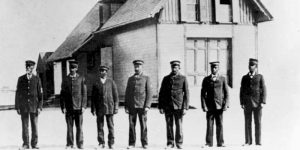
Etheridge’s Early Years
When there was suddenly an opening for Keeper of the Pea Island Life-Saving Station, a surprising thing happened. The new Keeper selected for the Pea Island Station was a local surfman from nearby Bodie Island Life-Saving Station. His name was Richard Etheridge. His appointment was surprising, because up to that point he had only been Surfman No. 6, the lowest ranking surfman at the time. It was unheard of be promoted from No. 6 directly to the Keeper position.
Even more unheard of, though, was the fact that he was African American.
The Setting
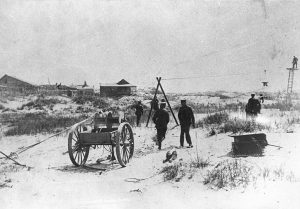
All stations were governed by a strict set of highly specific and detailed rules and regulations. This was through a 5½ x 9 inch, roughly 200-page manual entitled “REGULATIONS FOR THE GOVERNMENT OF THE LIFE-SAVING SERVICE OF THE UNITED STATES,” and it was issued to every station, and updated every year.
The Duties
Every station in the country – including Pea Island – did the same routine every day of the week. On Monday they practiced the beach apparatus drill; Tuesday the surfboat drill; Wednesday the flag signaling practice; Thursday was a repeat of the beach apparatus drill, showing its importance; Friday they learned and practiced First Aid; Saturdays were used for cleaning, (and repairing, if needed), the Station and equipment, as well as themselves and their tools and clothes. Sunday was a day off, but they were on call.
By 1878, the year the first Pea Island station was constructed and became operational, in addition to these daily drills, every Surfman had two vital duties: (1) keeping the Watch, and (2) Beach Patrol.
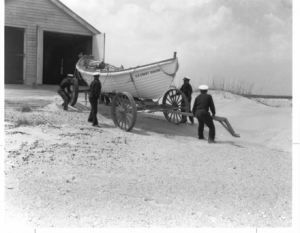
The beaches were covered 24 hours a day, seven days a week, a monumental task. If a shipwreck occurred, a station would know about it within minutes. It might take them hours to get there, but they knew of it and took action immediately. How did they do this? Every station had a watch tower, usually a tower on the highest level above the roof. These watch towers were manned from sun up to sundown. The stations in North Carolina averaged about six to seven miles apart. The watchman on one tower could see his neighboring stations to the north and the south. This obviously did not work at night, nor on days with visibility obscured by fog, rain, or storms.
Then it was time for the beach patrol. Two men from each station were sent to the beach at all hours of the watch. They would walk in opposite directions, heading towards their neighboring station. They would meet the neighboring station’s surfman on beach patrol halfway, chat, and exchange beach checks to prove to their Keeper that the patrol was complete.
Beach Apparatus Drill
One of two rescue methods performed by the surfmen of the United States Life-Saving Service was the Beach Apparatus Drill. The drill was practiced at each station every Thursday. Each station had a “wreck pole,” (or vertical drill pole), representing the mast of a ship with a single horizontal tree, or yard, forming a cross. Using a small bronze mortar called the Lyle gun, a shot was fired carrying a line. Using other specialized equipment, from the beach, the surfmen could establish a “zip line” allowing the survivors to be taken off one at a time, via the breeches buoy.
Surfboat Drill
The surfboats were small, 20+ foot, open wooden boats powered by oars which the surfmen called “arm-strong engines.” This practice was launched every Tuesday.
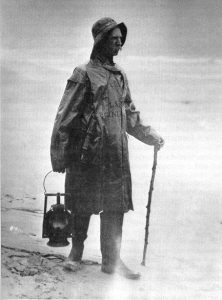
The Miraculous Rescue that was not “By the Book”
On the night of October 11, 1896, the three-masted schooner E. S. Newman ran hard aground somewhere near the Pea Island Station at 7:00 p.m. in the middle of a hurricane, with winds exceeding 100 miles per hour.
These torrents of wind enraged the Atlantic, producing gigantic waves, and pushing ocean waters clear to the Pamlico Sound. It’s said that there was literally no visible land — the island was completely awash.
The ocean was far too violent to launch the surfboat, so the crew manned the only other rescue equipment they had — the beach cart with the Lyle gun and breeches buoy.
But when the cart reached the bottom of the ramp of the station, it mired down into several feet of overwash. With seemingly superhuman effort, the six surfmen, pushing and pulling their two-ton cart by manpower alone, sloshed through the tide and spindrift until they reached the wreck site. The Annual Report of the Operations of the United States Life-Saving Service for the fiscal year ending June 30, 1897 states: “The sea was sweeping over the beach and threatened to prevent reaching scene of disaster, but they finally gained a point near the wreck.” Upon arrival, the surfmen heard from the ship what was later officially described in the records as “the voice of gladdened hearts.”
Exhausted and desperate, the surfmen attempted to mound up sands below the water as a perch for the Lyle gun. The 200-pound cannon simply sank. They were now out of rescue methods, but Keeper Etheridge almost immediately proposed a bold, daring — and impossible? — plan.
He asked for two volunteers. Two surfmen immediately stepped forward. One was Theodore Meekins, who had originally spotted the wreck. The plan was to tie a stout rope around the two men with one end of the rope anchored by the remaining crew on the beach. These two would carry another line with them, and then swim out into the deadly breakers. Why two tied together? In case one or both drowned. No man left behind; they would have a proper burial.
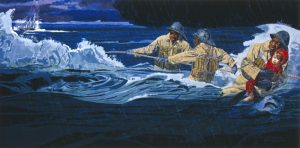
Indeed, they did go out, and miraculously, they reached the broken ship. On board was Captain Sylvester A. Gardener, his wife, their three-year-old son, Tommy, and a crew of six. The first line was tied around the terrified little Tommy, and he was taken ashore successfully. “In like manner, his wife and the seven men composing the crew were rescued under great difficulties and with imminent peril to the life-savers,” the Annual Report continued. Following nautical tradition, Captain Gardiner was last.
One by one, all were safely landed off the wreck by 9:00 p.m., but they were still a long way from safety. The seemingly impossible rescue finally concluded at 1:00 a.m., when all reached the Pea Island Station. As at all stations, the survivors were given sustaining food, water and complimentary dry clothes, which were always on hand at all stations. (“Succor” was the good old-fashioned word used at the time. All Wreck Reports are full of that word, naturally.)
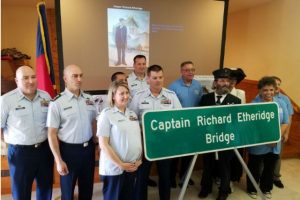
Normally, rescues involving such extraordinary bravery and heroics were rewarded with Life-Saving Service medals; Silver for extraordinary bravery and Gold for extreme bravery. This was surely extreme bravery, but Pea Island was not “normal.” They receive no medals … at least, not yet.
Belated Bestowal of Gold Medals
In 1995, Katie Burkhart, a 14-year-old white student in a North Carolina school, had chosen for her Social Studies project a report on the all-black Pea Island Life-Saving Station. She was amazed that it was so little known at that time, because she found it fascinating. When she reached the part about the incredible E.S. Newman rescue of October 11, 1896, she was appalled to discover that the Pea Island crew never received any awards simply because they were African Americans. She wrote to her North Carolina Senator, Jessie Helms, and also wrote to President Bill Clinton. She realized that the 100th anniversary was approaching. With the help of many, spearheaded by Rear Admiral Stephen Rochon, on October 11, 1996, descendants of that 1896 crew were awarded U.S. Coast Guard Life-Saving Gold medals in a fitting formal ceremony.
And now, the 125th Anniversary is here. A historic celebration for history: Black history, American history, and United States Coast Guard history!
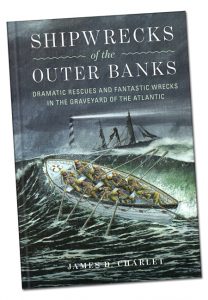 These are only excerpts from the far more detailed Chapter 5 of “Shipwrecks of the Outer Banks: Dramatic Rescues and Fantastic Wrecks in the Graveyard of the Atlantic,” Globe Pequot Press (imprint of Rowman & Littlefield), ISBN 978-1-4930-3590-8 (Hardcover), 978-1-4930-3588-5 (Paperback), 978-1-4930-3589-2 (eBook) by James D. Charlet.
These are only excerpts from the far more detailed Chapter 5 of “Shipwrecks of the Outer Banks: Dramatic Rescues and Fantastic Wrecks in the Graveyard of the Atlantic,” Globe Pequot Press (imprint of Rowman & Littlefield), ISBN 978-1-4930-3590-8 (Hardcover), 978-1-4930-3588-5 (Paperback), 978-1-4930-3589-2 (eBook) by James D. Charlet.
For more information on “Shipwrecks of the Outer Banks: Dramatic Rescues and Fantastic Wrecks in the Graveyard of the Atlantic,” click here.


